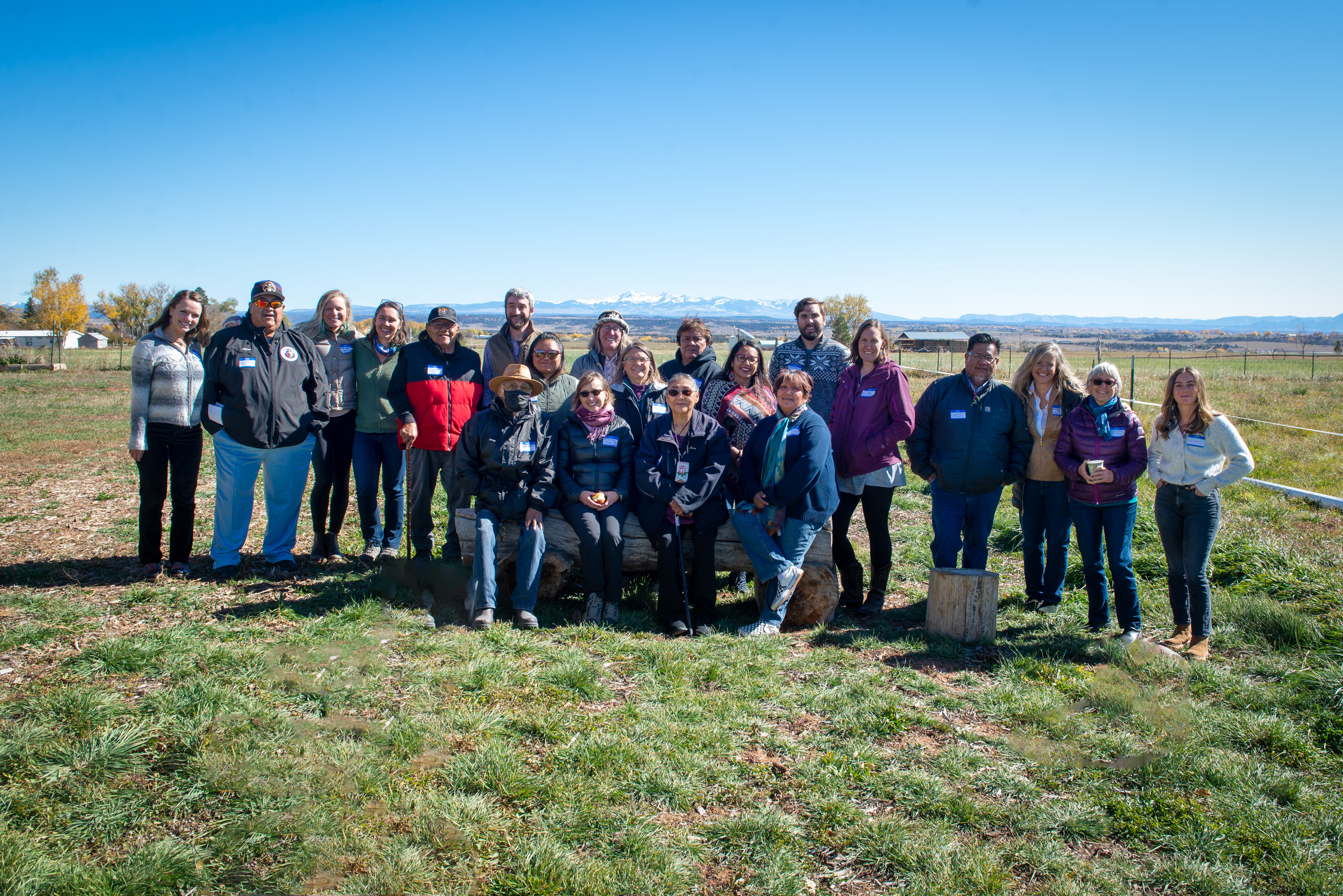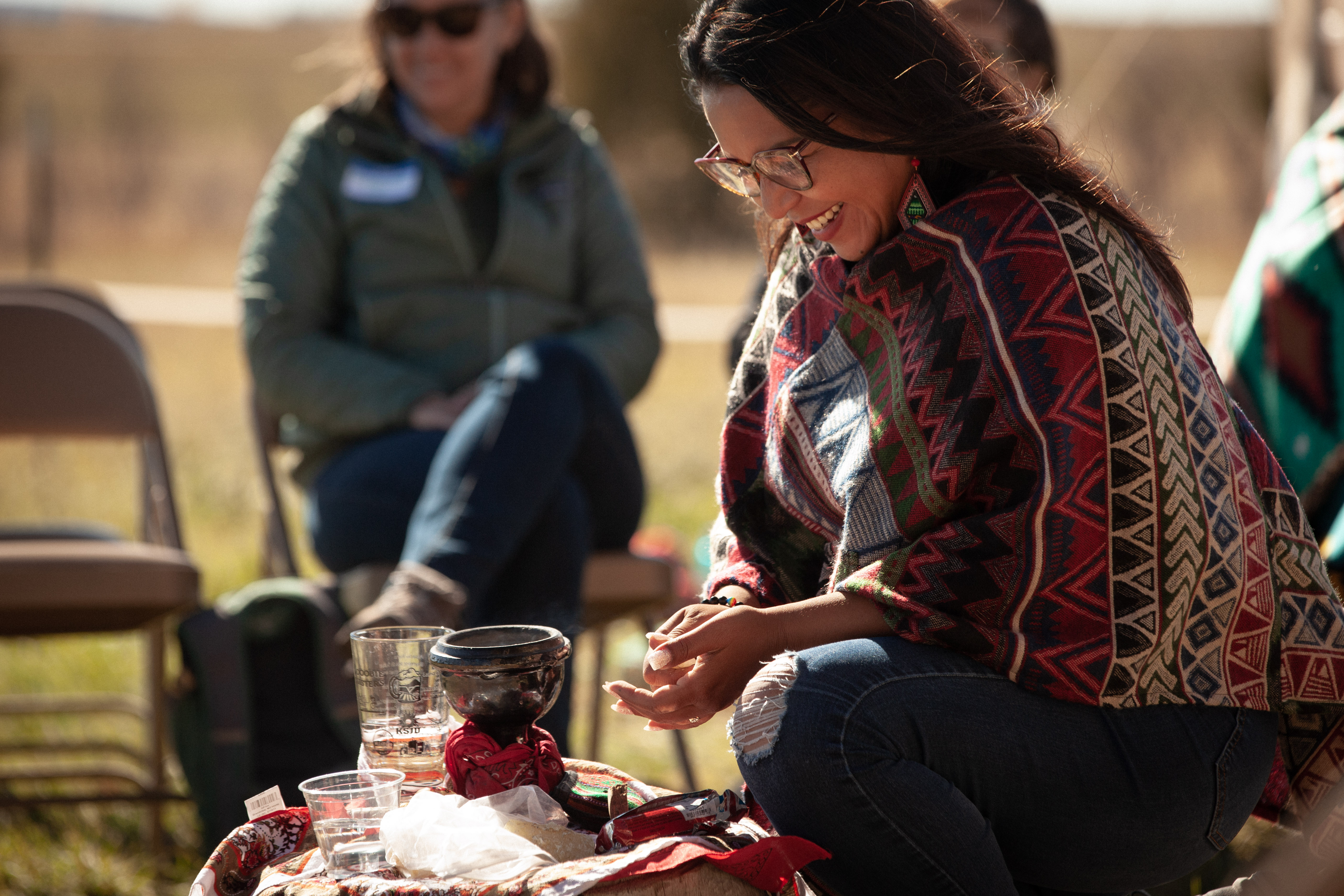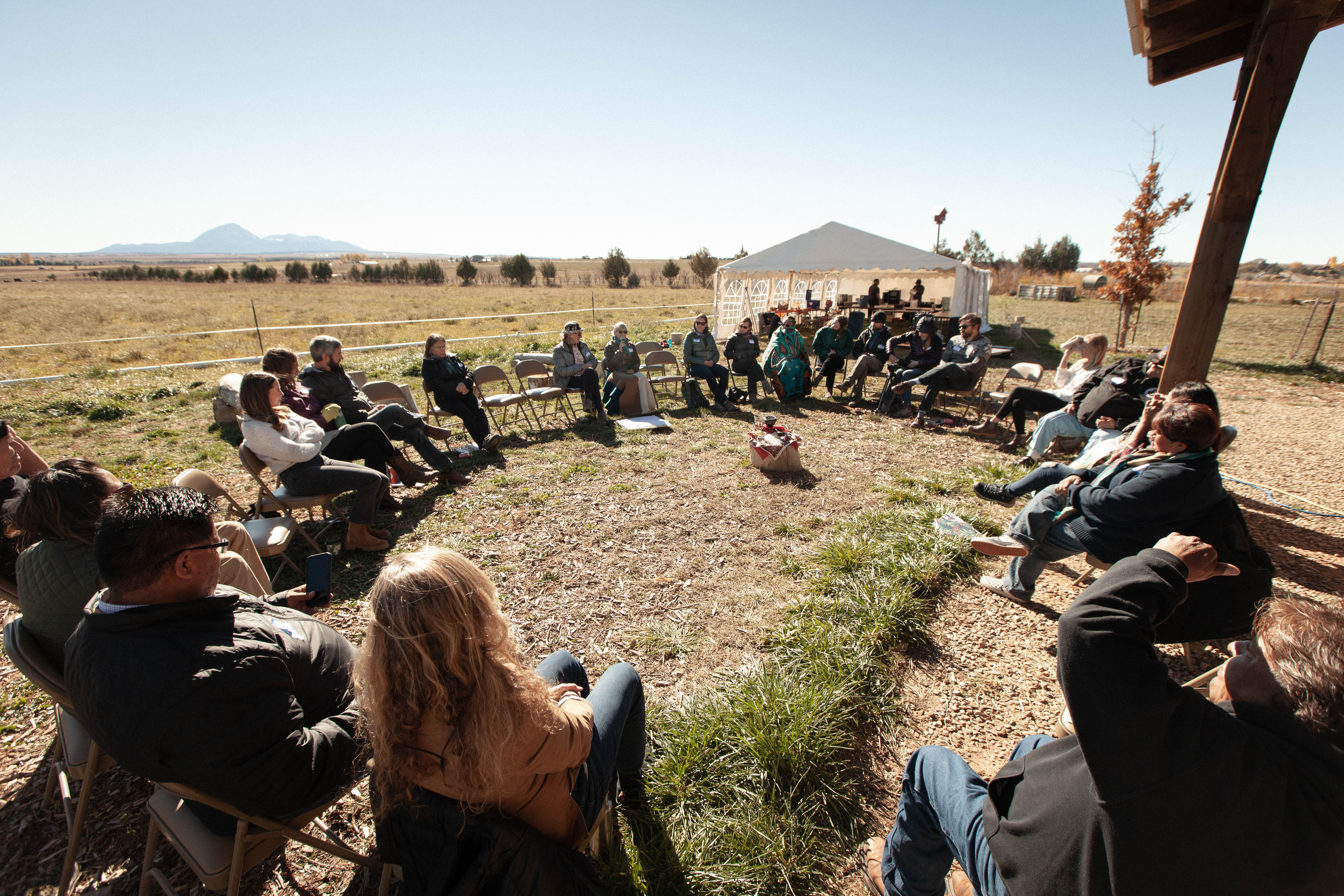Here, Emily Spahn describes a full-day event she attended along with others from her former fellowship host organization Montezuma Land Conservancy, the Telluride Institute, and Ute Mountain Ute Tribe. The groups came together on October 28, 2021 to develop a shared vision for their connection to the land and to each other. This event aimed to promote critical roundtable discussions and foster connection between key tribal and non-tribal community members through story-sharing. It gave everyone in attendance the opportunity to tell the stories that tie each person to the land we live on, to conservation as a whole, and, ultimately, to one another.
As I write this, I glance every so often at a picture perched at the bottom right side of my computer screen. It blocks a couple of the things at the bottom bar, the time, the battery percentage, the outside temperature, the messages waiting for me to read them. Instead, it shows a group of people, around 20 or so, all smiling at the camera. Four elderly folks sit on a wooden log; the rest fan out around them, standing on a large field of grass, the barbed wire fence peeking out behind their backs. In the background, you see the flat top of a bold mesa and the proud peaks of a mountain range. My eyes are drawn towards their snowy tops, crowning the heads of the people in the back row. I am in the back row, the last person on the left, a step away from the man next to me and you can tell I didn't know what to do with my arms.

This photo was taken at what we lovingly refer to as “Regina’s Event,” but in outreach materials we called it a longer name: “Connecting Land and Community Through Our Shared Stories.” I think either title does the event justice. The people in the photo are a mix of characters. Some I work with, others I had met only over Zoom, and some complete strangers. Whether or not I ever see them again, I feel connected to each and every person.
We gathered with the goal of, “sharing stories in order to develop a common vision for our connection to the land and to each other.” The day was special, it was emotional, it was about people, and it didn’t have the traditional deliverables that one would expect from a professional meeting. However, every single person I spoke with in the two months since we gathered had a unique experience that impacted both their personal and professional lives. Those outcomes are hard to create and even harder to quantify.
I believe the reason that we were able to cultivate these experiences is because of the hard work of Regina Lopez-Whiteskunk and Olga Gonzalez. They were responsible for planning and organizing the day and for fostering the connections between the tribal and non-tribal members who participated. They approach collaboration from a very human-centric perspective, creating time for conversation and being fluid with the interpretation of the agenda based on the sentiments of the attendees. I noticed that their thoughtful intentions for the ways we all interacted laid the foundation for future partnerships.
I work with Regina at Montezuma Land Conservancy (MLC), and every time I speak with her I learn something that makes me pause and really think. She is probably the most eloquent person I have ever met, and she has a way of speaking that brings the listener along. She questions the status quo in a gentle and compassionate way and she stays true to her values. I remember the first time I sat down with her. She said, “I want to see a place, specifically Montezuma County because I grew up here, that can erase the lines that people draw between the Tribe and the outside community, or any lines for that matter.”

Olga Gonzalez is the executive director of a non-profit in Denver called Cultivando and the owner of a business called O.G. Consulting Services. I was blown away by the way she was able to shape the sentiments of the attendees. She was intentional in creating a space where people felt comfortable enough to share and be vulnerable. “This vulnerability,” as one attendee put it, “is something that can really bring us together.”
We started the day with coffee and COVID tests. While I was waiting for the coffee to brew, an older man walked up to me. His name tag said Alfred and he had a cheery smile and a twinkle in his eye. He pointed over the back pasture of the farm and told me about how a long time ago, a white man rode up to an Indigenous person and asked him what the land was called. The Indigenous person said “Towaoc,” which is what the town on the edge of the Ute Mountain Ute reservation is called today. Then, with a cheeky grin on his face, Alfred told me that “Towaoc” means “turn around” or “go back” in the Ute language. Apparently, it also means “hello,” so he wrote Towaoc on his nametag, right under “Alfred.”
After introductions and some time for chatter, we spent time establishing group norms and setting intentions for the day. As we sat in a circle, a wooden stump in the middle of the room provided a pedestal for a vessel containing burning sage. In several Indigenous tribes, burning sage is believed to “reduce heaviness” and cleanse the area. This ritual was especially poignant to me because the sage brush habitat that is endemic to our region is slowly disappearing, so it served as a reminder about why we were all gathered there that day. Later that afternoon, several tribal members, including Regina, shared their gift of beautiful music. The elders played the drums, sang, and on person serenaded us with the sound of his pan flute. I learned that the pan flute is traditionally a way to play a love song for potential partners. We had long breaks to continue conversations, and the agenda that we had adhered to early in the day became more or less obsolete.

Near the end of the event, we all sat together in a circle and shared our stories based on a set of questions that Olga had prepared. For me, this was the most impactful part of the entire experience. These questions related to each of our individual stories, our connection to land, and the “carga,” or load, that we carry into each day. Every person who joined us at Fozzie’s Farm that day shared their answer and then placed the item that they brought in the center of the circle. It really struck me how connected the tribal members are to the land. I understood theoretically how long their ancestors had lived on this same piece of earth, but hearing their stories really brought all of that into perspective in a uniquely personal way. They talked about seeing the county grow, how things have changed on the reservation and that they still lack some basic human rights, like access to clean drinking water.
This brought up questions for me that I’ve been considering since the talking circle. How can we, relative newcomers to the land, truly expect to act with morality while knowing that these people, who have been here for longer than most of us can fathom, are suffering at our hands? I knew, theoretically, the impact that white settlers have had on both the land and on the Indigenous population, who are intrinsically tied to the land. However, hearing it from the tribal elders’ perspectives, was something that I will never forget. That made it personal for me and I remember feeling overwhelmed with shame.
So, as I continue my work in land conservation, I am reminded of the many paradoxes of my work. Private lands conservation primarily works to create conservation easements that limit the future development of the properties to protect certain conservation values. However, does this work go far enough? Who does this work primarily impact and benefit? And are there moral issues to consider when working to conserve lands and natural resources that were taken through colonizers’ manifest destiny?
Those questions are one of the reasons why MLC is working towards a community conservation model, especially in regards to reconciliation, trust, and healing with the Tribe. This model aims to bring the collective back into a redefined conservation. At MLC this means working to build relationships with other organizations as well as with the tribal leaders. It means asking the community what they value in conservation. It means creating an educational farm on a conserved property to foster a connection between youth and the land. It means spending the time to get to know each other and developing that trust as a first step to figure out ways to protect the land that we all rely on.
The result of this gathering was far more impactful than a list of goals, tidy deliverables, or a plan of action — at least for me and others who I have reminisced about the event with.
Estrella Woods, a GOCO program officer, said this about her experience at the event: “The result was more somatic. You had to be there to feel the connection.” Hence the picture at the corner of my computer screen as I write this—a reminder of the power of personal connection, the power of community, and the power of people who come together.
It also reminds me that sometimes just sitting with yourself and your feelings can be more important than the time, the date, the emails waiting in your inbox, or any other distractions that can prevent us from fully being present. Sometimes, flexibility and room for connection is needed to create the best foundation for true collaboration.
